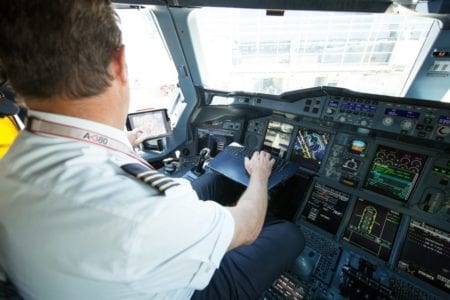GE’s FlightPulse application, powered by Predix, allows pilots to make fuel-saving decisions with real-time operational data.
Like many large companies, Qantas Airways, the Australian national carrier, has been working to become more sustainable. The airline has been introducing lightweight freight containers to cut fuel consumption, investing in electric-powered ground vehicles, and replacing lighting in all of its operational areas with energy-efficient LEDs. But when it wanted to cut its carbon footprint even more, the solution came in large part from one of the airline’s most treasured assets: Qantas pilots.
As a flight crew fuel manager, Qantas First Officer Dave Summergreene was “blown away by the wealth of data” the airline possessed. “But as a pilot, we had no way of knowing how to improve our own operational flying efficiency because we didn’t have the data,” he says. “We needed to get this data into the hands of pilots.”
As it turns out, General Electric had the same idea in mind when it developed a prototype for a fuel-efficiency app for pilots. However, what GE was missing was actual pilots, who could provide the insights and everyday experiences to make the idea work.
But in late 2016, everything clicked. Qantas and GE agreed to collaborate, and within a few months, 20 eager pilots signed on to test out the beta version of the app. The end result: FlightPulse, a new flight data and analytics application that lets pilots measure fuel use during every stage of a flight.
 In the summer of 2017, 1,700 pilots started using the app. “FlightPulse was designed by pilots for pilots,” says Captain Mike Galvin, head of fleet operations at Qantas. “It provides pilots with flight data in a very visual way, allowing them to see firsthand the amount of fuel used at different stages of a flight and how they can help to reduce carbon emissions.”
In the summer of 2017, 1,700 pilots started using the app. “FlightPulse was designed by pilots for pilots,” says Captain Mike Galvin, head of fleet operations at Qantas. “It provides pilots with flight data in a very visual way, allowing them to see firsthand the amount of fuel used at different stages of a flight and how they can help to reduce carbon emissions.”
FlightPulse, which is powered by GE’s Predix platform for the Industrial Internet, serves a group of professionals who are perfectly suited to the motivational influence of metrics. John Mansfield—vice president and chief digital officer for GE Aviation, and a former pilot—notes that even though the data remains anonymous, “we are all really kind of competitive and take a lot of professional pride in what we do. We want to get better at everything we do.”
There’s plenty of information to mine—on a single flight from Sydney to Dallas, FlightPulse can collect more than 30 million data points. The app allows the pilots to customize data to what’s most relevant to their flights. For example, pilots employ various techniques to save fuel, like shutting down an unneeded engine while taxiing to the gate after landing. This action can shave off 10 kilograms of fuel per minute.
With FlightPulse, pilots can now see data from every flight, illuminating how much fuel savings they’ve realized, where they can make improvements and how their use of the tool compares with that of their peers. The information is displayed on an iPad as part of the pilots’ Electronic Flight Bags. “Without data, pilots have to rely on estimates and theory, and hope their actions are really doing what they say,” explains Mansfield. “If you provide pilots with actual data, they can see the impact they are having and trust in the value of their actions.”
Before FlightPulse, pilots just stuck to industry standards—model-based estimates of the most-efficient ways to fly. Now, they can tweak their flying daily to precisely gauge the impact of operational decisions. For instance, pilots already knew they could save 45 kilograms of fuel per flight by using idle power on the thrust reversers when landing on a long runway (as opposed to running up the engines after touchdown to help brake the aircraft). But with FlightPulse, they can see how often they’re doing this, how their utilization compares with that of other pilots, how they’re doing on the runways they land the most on, and whether their rates of use are improving over time.
As is often the case, the potential for data-driven improvements are boundless. FlightPulse was designed to be configurable, and Qantas wants to expand its current palette of measures, which cover everything from optimal fuel planning to flap settings on landing. The rich data source provided by modern aircraft will help enhance the information available to pilots through FlightPulse. In the meantime, connecting FlightPulse with pilots is a major first step.
A version of this story originally appeared on GE Reports, a site that covers GE’s industrial transformation. Image courtesy of Qantas.


Share this: